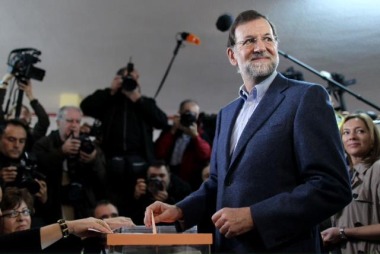 |
| Mariano Rajoy casting his vote |
The environment for Spanish nuclear power appears to be changing with the election of a People's Party government and publication of a study on the country's new-build capabilities.
Mariano Rajoy took the conservative People's Party to a memorable victory on 20 November, claiming around 44% of the vote and ending seven years in opposition to José Luis Zapatero's Socialist Workers Party.
Rajoy had been subdued on the subject of nuclear power during his campaign and has said nothing about energy since the election. However, the party's manifesto included a commitment to use an energy mix including all sources without sacrificing any of them, in contrast to the Socialists who had maintained an anti-nuclear stance.
The country gets about 20% of power from eight nuclear reactors built as part of a long-term program that ended in 1984 with the imposition of a moratorium on new build. At that time, four large reactors were scrapped mid-construction, while Trillo was completed as Spain's newest unit in 1988. A further political bind developed for nuclear operators in a requirement for ministerial approval - on top of regulatory approval - each time a ten-year extension is granted to a reactor's operating licence. Until February this year, these decisions took place against an assumption of 40 years as a typical lifespan.
This 40-year assumption was used by ministers to refuse a ten-year extension to the Garoña plant in 2009, giving just four years instead. The People's Party has previously said it would maintain that decision but for technical reasons rather than political ones, notwithstanding the regulator's opinion that the plant would be safe for continued operation given certain technical improvements.
As if anticipating a new debate on energy policy and nuclear power, the Strategic Nuclear Research and Development Committee (CEIDEN) has now released a report on the capabilities of the Spanish nuclear industry to support a program of new reactors.
At the height of the Spanish nuclear program in 1980 there were ten reactors under construction simultaneously, and in 1988 at the end of that build phase Spanish companies had an 85% share of the financial value of the Trillo reactor project. CEIDEN believes Spanish industry could take 77% of a new reactor project, some 23 years later. Five years into a new-build program the figure could reach 83%, it said.
This capability is thanks in large part to a strong program of uprates at existing power plants and good success in exporting nuclear goods and services over the years.
"The world's economic and social development cannot do without nuclear power," said CEIDEN. It also noted the economic benefits to Spain from a positive return to nuclear "would be huge, owing to both the creation of highly qualified technical jobs... and the boost of the nuclear sector as a driver of the country's economy" with direct and indirect effects.
Researched and written
by World Nuclear News




_18570.jpg)
_16159.jpg)
_18938.jpg)
_33584.jpg)





